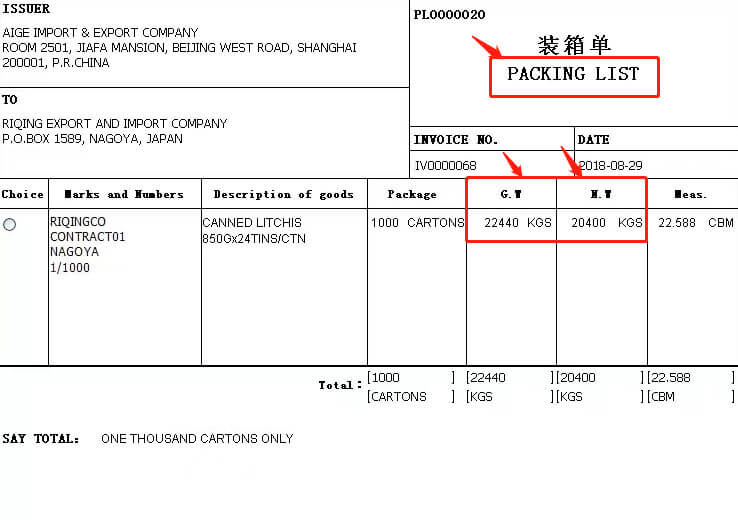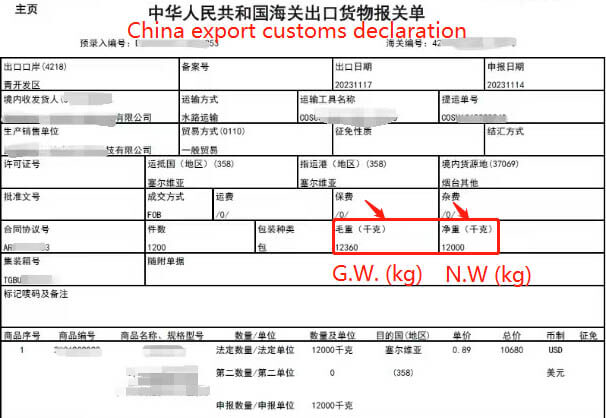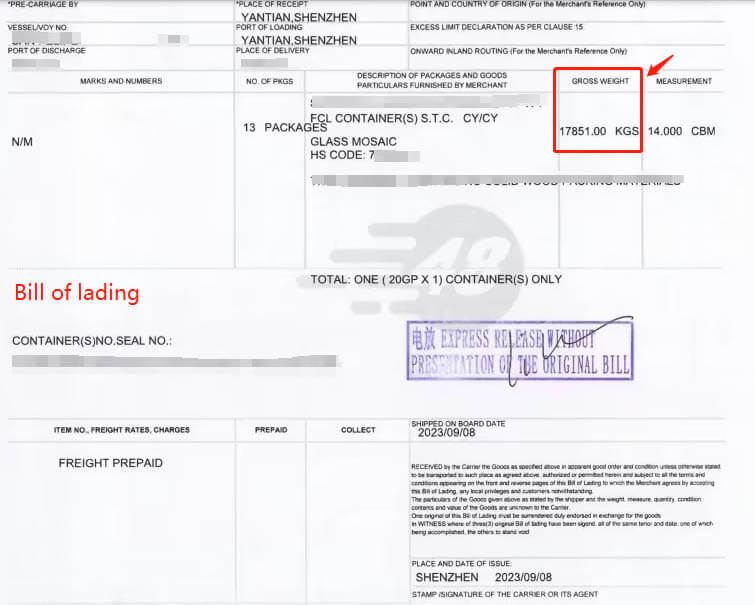Ever mixed up net weight, gross weight, and tare weight while shipping products internationally? You’re not alone. Today’s blog is perfect for gaining a quick understanding of these three weights, including how to calculate them and their differences, all explained through examples.
What is net weight?
Net weight (N.W.) refers to the actual weight of the product alone, without any packaging. For example, the weight of an iPhone 15 Pro Max, just the phone itself, is 221 grams (g). This is the phone’s net weight.
Cargo net weight calculation and example
Net weight formula:
Net weight = Total number of units x Actual weight per unit
Example:
Assume you import 2,000 pairs of shoes from China. Each pair of shoes without packaging weighs 1.14 kilograms (kg).
Net weight per pair = 1.14 kg (2.51 lbs)
Net weight of this shipment = 2,000 x 1.14 = 2,280 kg (5,026 lbs)
What is gross weight?
Gross weight (G.W.) includes the product’s weight and all packaging materials. For instance, when you buy an iPhone 15 Pro Max, the weight of the parcel you receive is the gross weight. This includes the iPhone, screen protector, packaging boxes, and possibly shock-absorbing filler materials like air pillows.
For a large shipment, such as a factory exporting 10,000 mobile phones, the gross weight includes the weight of all phones plus all filling and outer packaging materials, such as product packaging boxes and cartons, etc.
Cargo gross weight calculation and example
Gross weight formula:
Gross weight = Product net weight + Weight of all packaging materials
Continuing with the shoe example
Package each pair in a shoebox, along with a dust bag and paper envelope, adding 0.25kg.
Gross weight per pair = 1.14 + 0.25 = 1.39 kg (3.06 lbs)
Weight of all these packaging materials = 0.25 x 2,000 = 500 kg (1102.31 lbs)
Pack 10 pairs into one carton box, with a total of 200 regular carton boxes. Additionally, there’s also a pallet weighing 600 kg to protect this shipment.
Gross weight per carton = 1.39 x 10 = 13.9 kg (30.64 lbs)
Weight of all packaging materials = 500 + 600 = 1,100 kg (2425.08 lbs)
Here, the gross weight of this shipment can be calculated in 2 ways:
Cargo gross weight = Gross weight per carton x Carton numbers + Pallet weight = 13.9 x 200 + 600 = 3,380 kg (7451.62 lbs)
Cargo gross weight = Cargo net weight + Weight of all packaging materials = 2,280 + 1,100 = 3,380 kg (7451.62 lbs)
No matter which method you use, the calculated cargo gross weight is the same: 3,380 kg or 3.38 metric tonnes.
Net weight vs gross weight
Net weight and gross weight are two different ways to measure weight. Gross weight is the total weight of the products plus all the packaging it comes with, like when it’s all dressed up. While net weight is just the weight of the item itself, as if it were undressed.
Both are crucial for shipping, calculating freight costs, and customs declarations.
Typically, some shipping documents will specify the net weight and gross weight of the goods. For example, this information may appear on commercial invoices, but it’s not mandatory and depends on your supplier.
Note the following 3 types of shipping documents must include the net weight and gross weight of the goods.
Packing List: Details each package or carton box, including the shipment net and gross weight, helping with customs inspections and buyer verifications. Here is a packing list sample with the net and gross weight info.
Customs Declaration Form: A detailed declaration by your supplier or freight forwarder to the export customs, including the gross and net weight of the goods. Here is a China export declaration document sample with the net and gross weight info.
Import Customs Declaration Form: Detailed information declared by importers or entrusted customs brokers to destination port customs, including the gross and net weight of the goods.
In addition, the shipment gross weight must also be declared on the bill of lading, as shown below. Declaration of the net weight is optional.
What is tare weight?
The tare weight, also known as the “unladen weight,” is the weight of an empty container. That is the net weight of a shipping container without any goods loaded into it.
In the given example, a batch of shoes imported from China is loaded into a 20-foot container that weighs 2,200 kg when empty. Under this case:
Tare weight of a 20-foot container = 2,200 kg (4850.17 lbs)
The tare weight of a container is determined when it is manufactured and is typically marked on the exterior of the container. Containers of the same type and size generally have similar tare weights because manufacturers adhere to international standards during production. However, if a container undergoes major repairs or modifications, its tare weight may change. In such cases, the updated tare weight will be marked on the container.

In practice, you’ll know the container tare weight by simply checking the container markings, or directly consulting with logistics agents.
Tare weight vs gross weight
For containerized cargo, tare weight is the empty container’s weight, while gross weight is the total weight of the container with its loaded goods. For example, if you’re preparing for a hike, think of your backpack as a container. The backpack has its own weight (tare weight), and when you add your items, the total weight (gross weight) is what you’ll carry.
For the example of importing shoes mentioned above, the calculation for the gross weight of the containerized cargo would be as follows:
Containerized cargo gross weight = container tare weight + cargo net weight + weight of all packaging materials = 2,200 + 2,280 + 1,100 = 5,580 kg (12301.79 lbs)
Containerized cargo gross weight = container tare weight + cargo gross weight = 2,200 + 3,380 = 5,580 kg (12301.79 lbs)
As required by IMO (International Maritime Organization), the “gross weight” of containerized cargo must be declared before loading onto the vessel. This declaration, known as the Verified Gross Mass (VGM), includes the container’s tare weight, the net weight of all loaded cargo, and the weights of all shipping and packaging materials in the container, such as pallets.
If the gross weight of your container exceeds its maximum payload capacity, you will need to pay additional charges, and it may not be loaded onto the vessel due to safety considerations. This is similar to a situation where your backpack and its contents exceed the maximum weight limit, requiring you to either reduce the items carried or choose a backpack with a higher weight capacity.
Further questions and answers
What are net weight and dr weight?
Net weight is the weight of every matter inside the container or can, including solid, liquid, and gas. In comparison, dr weight refers to solid material weights only, which are inside the container.
What is net weight ounces?
It is important to understand that items are measured in net weight. While liquid products are measured in fluid ounces. Therefore, the term net weight ounces or NET WT.OZ is a mass measurement to know how heavy the liquid product is.
What is the difference between KERB weight and tare weight?
The term “KERB” is specifically used to define a car or vehicle’s weight without travelers or luggage. Contrarily, tare weight is the term used to determine the empty container weight. Both terminologies have the same concept but are utilized to define the weight of two separate objects
What is the difference between payload and tare weight in shipping?
Payload defines the maximum weight limit of cargo that a single shipping container can carry. Payload excludes the tare weight — the empty container weight.
Final words
We hope this guide to gross weight, net weight, and tare weight has been helpful. If you have any questions or find any part of this guide confusing, please feel free to leave a comment below. We’ll respond to your questions promptly.
We are Jingsourcing, a leading sourcing company based in China, dedicated to helping businesses source and ship a wide variety of products from China. With years of experience, we can manage and declare all cargo weights to ensure smooth shipping. More importantly, we can tailor the best shipping methods for your shipments to save on costs. Feel free to contact us for your import needs in China.




Leave A Comment